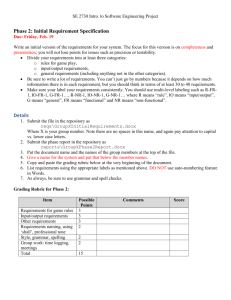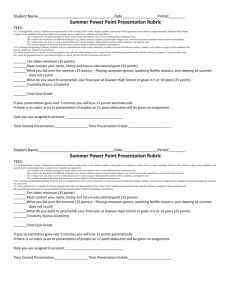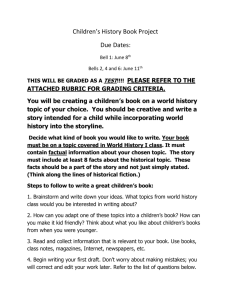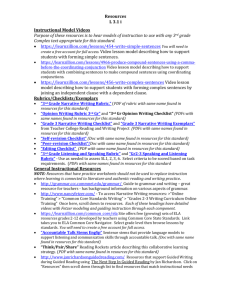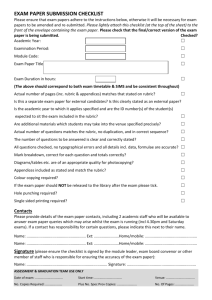Middle and High School Literacy Plan Overview
advertisement
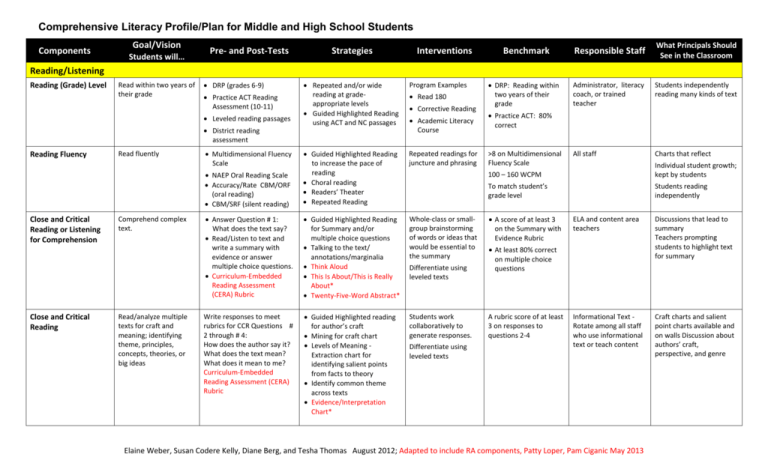
Comprehensive Literacy Profile/Plan for Middle and High School Students Components Goal/Vision Students will… Pre- and Post-Tests Strategies Interventions Benchmark Responsible Staff What Principals Should See in the Classroom Reading/Listening Reading (Grade) Level Read within two years of their grade DRP (grades 6-9) Repeated and/or wide reading at gradeappropriate levels Guided Highlighted Reading using ACT and NC passages Program Examples Repeated readings for juncture and phrasing NAEP Oral Reading Scale Accuracy/Rate CBM/ORF (oral reading) CBM/SRF (silent reading) Guided Highlighted Reading to increase the pace of reading Choral reading Readers’ Theater Repeated Reading Answer Question # 1: What does the text say? Read/Listen to text and write a summary with evidence or answer multiple choice questions. Curriculum-Embedded Reading Assessment (CERA) Rubric Guided Highlighted Reading for Summary and/or multiple choice questions Talking to the text/ annotations/marginalia Think Aloud This Is About/This is Really About* Twenty-Five-Word Abstract* Whole-class or smallgroup brainstorming of words or ideas that would be essential to the summary Write responses to meet rubrics for CCR Questions # 2 through # 4: How does the author say it? What does the text mean? What does it mean to me? Curriculum-Embedded Reading Assessment (CERA) Rubric Guided Highlighted reading for author’s craft Mining for craft chart Levels of Meaning Extraction chart for identifying salient points from facts to theory Identify common theme across texts Evidence/Interpretation Chart* Students work collaboratively to generate responses. Practice ACT Reading Assessment (10-11) Leveled reading passages District reading assessment Reading Fluency Close and Critical Reading or Listening for Comprehension Close and Critical Reading Read fluently Comprehend complex text. Read/analyze multiple texts for craft and meaning; identifying theme, principles, concepts, theories, or big ideas Multidimensional Fluency Scale Read 180 Corrective Reading Academic Literacy Course Differentiate using leveled texts Differentiate using leveled texts DRP: Reading within two years of their grade Administrator, literacy coach, or trained teacher Students independently reading many kinds of text All staff Charts that reflect Practice ACT: 80% correct >8 on Multidimensional Fluency Scale 100 – 160 WCPM Individual student growth; kept by students To match student’s grade level Students reading independently A score of at least 3 on the Summary with Evidence Rubric ELA and content area teachers Discussions that lead to summary Teachers prompting students to highlight text for summary Informational Text Rotate among all staff who use informational text or teach content Craft charts and salient point charts available and on walls Discussion about authors’ craft, perspective, and genre At least 80% correct on multiple choice questions A rubric score of at least 3 on responses to questions 2-4 Elaine Weber, Susan Codere Kelly, Diane Berg, and Tesha Thomas August 2012; Adapted to include RA components, Patty Loper, Pam Ciganic May 2013 Comprehensive Literacy Profile/Plan for Middle and High School Students Components Goal/Vision Students will… Pre- and Post-Tests Strategies Interventions Benchmark Responsible Staff What Principals Should See in the Classroom Profundity for Reading Fiction Read fiction and determine the themes/principles/big ideas. Respond to the scales of profundity with a piece of fiction scored using the profundity scales. Written or oral response to each plane of the profundity scale. Students work collaboratively to generate responses to each plane of the scale Internalized profundity applied seamlessly ELA teachers Literature discussion focusing on character that leads to theme and life lessons Read Informational Text for Argument Recognize argument in text Analyze text written as argument to identify the parts of an argument: claim, evidence, counterclaim, and rebuttal Inquiry and/or GHR to identify and compare Toulmin’s elements of argument: claim, evidence, counterclaim, and rebuttal Differentiate using leveled argument texts MS: Correctly identify claim and evidence. All teachers using informational text and literary non-fiction Students using the Stephen Toulmin's elements of argument in discussion Graphic organizers HS: Correctly identify claim, evidence, counterclaim, and rebuttal. Writing/ Speaking Modes of Discourse Compose written and spoken narrative, informative/explanatory , and argumentative text. All-school writing to prompts or performance tasks. Score with SBAC and MEAP/MME rubrics Shift focus from narrative; increase informative/ explanatory, and argument. Mini lessons on Smarter Balanced rubric traits, text structure, and formal style (CCSS Appendix C Student writing samples) Text structure charts Text structure card game Use mentor texts as models for student writing Analyze and discuss traits of mentor texts Go Edit Card Game Revision Rummy “They Say, I Say” templates Graphic organizer for structure Text structure card game Scaffolding Academic Conversation* Sentence Frames that Support Academic Conversation* Students score at least a 3 on the Smarter Balanced rubrics for argument and informative/explanatory writing ELA and content- area teachers Students’ access to rubrics for each mode of discourse, exemplary writing pieces, and Toulmin’s elements of an argument Writing Fluency Write continuously for five minutes. Choice or prompted writing for five minutes. Students count and record the number of words written. Brainstorm verbs and nouns Mnemonics (ex: parts on your fingers) MS: 100–125 words per 5 minutes HS: 125-150 words per 5 minutes Students score at least a 3 on the Smarter Balanced rubric for brief writing Rotate among mathematics, science, social studies Writing tracker folders with pieces of writing and tracker chart Writing Tracker Quick writes Prompted writes Turn and talk in preparation for writing. Text structure card game Brainstorm domain-specific words Elaine Weber, Susan Codere Kelly, Diane Berg, and Tesha Thomas August 2012; Adapted to include RA components, Patty Loper, Pam Ciganic May 2013 Students writing during content-area class time Comprehensive Literacy Profile/Plan for Middle and High School Students Components Persuasive Writing Goal/Vision Students will… Create a persuasive essay on demand. Pre- and Post-Tests ACT prompt/rubric Practice ACT Assessment Electronic version on MeL.org Student ACT writing exemplars Strategies Interventions Pro-Con research, discussion, and debates Provide students with research on opposing viewpoints. Analyze and discuss methods used in effective persuasive texts. Benchmark ACT Standards rubric scored, revised to a 5 or 6 Responsible Staff What Principals Should See in the Classroom ELA high school teachers The ACT rubrics and sample persuasive essays Essays from the previous year’s 11th grade students Graphic organizers for structure Students writing/revising Mini-lessons on ACT rubric traits, text structure, and formal style Persuasive writing prompts Steps for revising ACT writing to score of 5 or 6 Handwriting Write legibly and fluently Students copy a passage for 1.5 minutes. Score with grade level/gender chart and legibility rubric. ---- Training on proper holding of pencil (ex: hold cotton ball with ring finger and pinky) Practice copying text Oral Language Speak in complete sentences with proper pronunciation and prosody. Middle School: Recite the Pledge of Allegiance High School: Gettysburg Address Score with rubric Students select 2-3 sentences from text and read out loud to small groups to enhance listeners’ understanding of the content. Readers’ Theater More practice with Readers’ Theater, choral reading, repeated readings, and recitation of poetry. Letters per minute: Students score at level consistent with grade level and gender All teachers Legible student writing All teachers Students speak in an articulate manner Score at least 4 on rubric for legibility Recite with complete, coherent sentences Choral reading Repeated readings Poetry Recitation Elaine Weber, Susan Codere Kelly, Diane Berg, and Tesha Thomas August 2012; Adapted to include RA components, Patty Loper, Pam Ciganic May 2013 Comprehensive Literacy Profile/Plan for Middle and High School Students Components Goal/Vision Students will… Pre- and Post-Tests Strategies Interventions Benchmark Responsible Staff What Principals Should See in the Classroom Word Study Vocabulary Acquire general academic vocabulary knowledge, particularly words found on the Smarter Balanced grade level vocabulary list Pre and post with a cloze procedure on selected words Pre-Assessment : Vocabulary self-awareness chart Post assessment : Jim Burke Vocabulary Squares GHR for Vocabulary Marzano’s 6 Steps Vocabulary Squares Frayer Concept Attainment Model Linear Arrays Vocabulary Trees Vocabulary Notebook Word sorts Word Lists (SBAC, academic and domain-specific) Survival Words* Word Pattern Investigations* Struggling students should be given more opportunities for speaking, writing, and using the words through activities listed under strategies. 100% of Grade and content- appropriate academic vocabulary words from Smarter Balanced grade level vocabulary list All teachers Self-awareness chart, data chart, word walls, evidence of vocabulary activities Spelling Understand how words are constructed Words their Way Upper level spelling inventory Word study activities Syllables, affixes and derivational relations Students analyze their spelling assessment using the feature analysis chart. They document areas of need. Activities to support students’ stage through derivational relations stage (ex: word sorts, separating root words, prefixes, suffixes, etc.) Spelling skills up through derivational relations stage ELA Teachers Appropriate word study activities Guided Highlighted Reading for grammar errors and word usage Use diagnostic tests for continued progress monitoring Students score at least 80% on assessment English teachers and/or literacy coaches Mini-Lessons (10 min.) based on student need Peer editing practice Mock assessments with explanations of choice Use diagnostic tests for continued progress monitoring Correction and explanations of grammar and word usage – limit to 2-3 daily Guided Highlighted Reading activities for grammar errors and word usage Feature guides Grammar and Word Usage Grammar of the ACT and ELA Common Core Standards Use correct grammar and word usage in the context of text at the appropriate grade level Identify and correct 15 errors of grammar and word usage (ACT English Test Preparation from Dakota State University) or ACT mock assessment for grammar and word usage. Grammar assessments from MISD HS Literature Units One-to-one teacher student conferences Additional minilessons based on student need. *Reading for Understanding, Second Edition by Schoenbach, Greenleaf, and Murphy. Elaine Weber, Susan Codere Kelly, Diane Berg, and Tesha Thomas August 2012; Adapted to include RA components, Patty Loper, Pam Ciganic May 2013 Students collaborating to identify grammar errors and make corrections Short grammar minilessons
